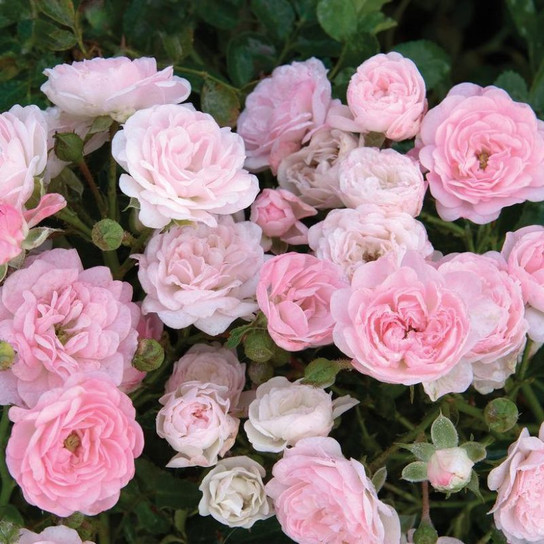
Milkweed
Uses:
- Border Plant
- Container Gardens
- Wildlife Gardens
Features:
- Attracts Butterflies
- Cut Flowers
- Fragrant Flowers
Sunlight:
- Partial Sun to Full Sun
- At Least 5 Hours of Direct Sunlight
Growing Zones:
- 3-11
- What is My Zone?
Milkweed is a native perennial known for its clusters of fragrant, pink, orange, or white flowers that bloom in summer. The plants provide essential habitat for monarch butterflies and other pollinators. Milkweed is ideal for wildflower gardens, pollinator gardens, or naturalized areas, where it can support biodiversity.
About Milkweed

Butterfly Weed, silkweed, silky swallow-wort, and Virginia silkweed
North America
Perennials
Herbaceous
3-9
Green, pink, white, and purple or lavender
Summer
Upright
Bees, Butterflies, Hummingbirds
Drought, Dry Soil
Deer, Pests, Diseases
How To Use Milkweed In The Garden
Milkweed, an upright, medium-sized plant reaching 3 to 4 feet in height, showcases clusters of flowers in shades of white, lavender, orange, red, or yellow, depending on the variety. Native to North America, this herbaceous perennial dies back in cold weather and is a host plant for monarchs. Tropical milkweed retains live growth year-round in warm climates. The intricate flowers fuel diverse pollinators, from bumblebees to hummingbirds, across arid plains to rain gardens.
Incorporate milkweed as a backbone in prairie reconstructions, massing taller species like common milkweed in meadows to stabilize soil and form monarch corridors. Pair shorter cultivars like Asclepias tuberosa with rudbeckia and grasses in sunny borders for contrast, or cluster swamp milkweed near water features to merge function with magenta spires. For urban plots, contain rhizomatous types in sunken barriers or raised beds, leveraging their verticality to soften hardscapes. Schools and parks deploy milkweed patches as living labs, demonstrating symbiotic relationships while resisting deer browse and drought.
Types of Milkweed
| Type | Scientific Name | Native Range | Flower | Zones | Uses | Features |
|---|---|---|---|---|---|---|
| Swamp Milkweed | Asclepias incarnata | E.–C. U.S./Canada – wet meadows, swamps | Pink-mauve, fragrant umbels | 3–6 | Rain & pollinator gardens, pond edges | Monarch host; tolerates clay & wet soil; deer resistant; fragrant |
| Butterfly Weed | Asclepias tuberosa | E.–S. U.S. dry prairies | Bright orange (to yellow) flat umbels | 3–9 | Meadows, rock gardens, slopes | Drought/erosion tolerant; clear sap; long bloom; Monarch & pollinator magnet |
| Showy Milkweed | Asclepias speciosa | W. North America | Purplish-rose, star-shaped clusters | 3–9 | Naturalize, prairie, borders | Fragrant crowns; less spreading than common milkweed; drought & deer tolerant |
| Tropical Milkweed (Blood-flower) | Asclepias curassavica | Tropical America | Red-orange with yellow hoods, cymes | 9–11 (annual elsewhere) | Annual beds, large pots | Late nectar source; drought & deer tough; Monarch host; toxic to livestock |
| Whorled Milkweed | Asclepias verticillata | Most of U.S./S. Canada (dry prairies) | Greenish-white mini-clusters | 4–9 | Xeric meadows, naturalize | Threatened in parts of Midwest; less aggressive than common milkweed; strong monarch & pollinator draw |
| Prairie Milkweed | Asclepias sullivantii | Central U.S. moist prairies | Uniform pink, fragrant umbels | 3–7 | Prairie restorations, sunny borders | Strong monarch & pollinator draw |
| Narrowleaf Milkweed | Asclepias fascicularis | W. U.S. (CA-WA, Great Basin) | Pale pink-lavender clusters | 6–10 | Water-wise beds, wildflower meadows | Key Monarch host in West; very drought tolerant; tolerates clay and saline soils |
| Balloon Plant (Hairy Balls) | Gomphocarpus physocarpus | S.E. Africa (tender) | Small white-pink clusters | 8–10 (annual north) | Specimen, cut-pod arrangements, large containers | Inflated spiny “balloon” pods; fast grower; monarch host; deer & drought tolerant; interesting cut stems |
Milkweed Care
Milkweed requires at least six hours of direct sunlight daily and thrives in well-draining soil. While it can tolerate poor-quality, rocky soil, incorporating organic compost during planting can enhance growth. Water the plant when the top few inches of soil are dry; once established, milkweed exhibits drought tolerance. Fertilization is generally unnecessary, as milkweed is not a heavy feeder.
Pruning involves cutting back growth in the fall after flowering to maintain plant health. For winter care, especially in colder climates, trim the plant back and, if potted, store it in a protected area like a garage or shed to shield roots from freezing temperatures. When growing milkweed in containers, use rich, well-draining soil and consider applying a balanced, water-soluble fertilizer monthly during the growing season to encourage new growth and blooms.
Learn More About Milkweed Care

Milkweed Companion Plants
Milkweed is a good choice to feature in butterfly gardens or any outdoor space because the flowers last from spring until late summer. Select other sun-loving companions such as weigela, roses, coneflower, and verbena to extend the bloom period and offer pollinators a diverse buffet.

























